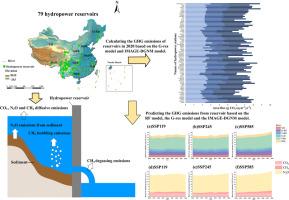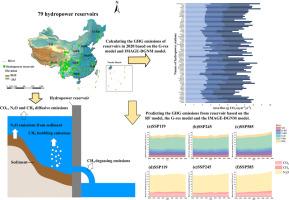从2020年到2060年,中国水电水库的温室气体排放主要是一氧化二氮
IF 12.4
1区 环境科学与生态学
Q1 ENGINEERING, ENVIRONMENTAL
引用次数: 0
摘要
中国正雄心勃勃地提高水电比重,以减缓气候变化。水电站水库的温室气体排放可能会阻碍气候目标的实现。目前尚未明确研究在全国范围内未来气候变化下此类排放的时空模式。在本研究中,我们利用 G-res(温室气体水库)工具和全球环境综合评估模型-全球动态营养模型(IMAGE-DGNM),评估了 2020 年中国 79 座水电站水库(占全国水力发电量的 61.22%)的二氧化碳(CO2)、甲烷(CH4)和一氧化二氮(N2O)排放量。此外,还使用随机森林(RF)模型预测了在共享社会经济路径(SSP)情景下 2020 年至 2060 年期间的排放量。结果表明,碳强度(CI)和面积通量变化很大。位于低海拔地区的水库和老旧水库的碳强度通常较高。N2O 占温室气体排放总量的 80% 以上,其中 NH4+ 浓度是影响 N2O 排放的关键因素。预测结果显示,在 SSP119、SSP245 和 SSP585 情景下,与 2020 年相比,到 2060 年这些排放量将分别增加 1.30%、6.63% 和 17.33%,其中 CH4 的增幅最大。最后,讨论了减少此类排放的影响。本文章由计算机程序翻译,如有差异,请以英文原文为准。


Nitrous oxide dominates greenhouse gas emissions from hydropower's reservoirs in China from 2020 to 2060
China is ambitious to increase its hydropower share to mitigate climate changes. The greenhouse gas (GHG) emissions from hydroelectric reservoirs may hinder the climate goal. The spatio-temporal patterns of such emissions under future climate changes at the national scale are not clearly addressed. In this study, we evaluate these emissions from 79 hydroelectric reservoirs across China (61.22 % of the national hydropower generation) in 2020, covering carbon dioxide (CO2), methane (CH4), and nitrous oxide (N2O), using the G-res (Greenhouse Gas Reservoir) tool and Integrated Model to Assess the Global Environment–Dynamic Global Nutrient Model (IMAGE-DGNM). A random forest (RF) model is also used to project the emissions in the period of 2020 to 2060 under Shared Socioeconomic Pathway (SSP) scenarios. The results indicate that the carbon intensity (CI) and areal flux varied largely. The reservoirs located in low-altitude areas and older reservoirs generally have higher CIs. N2O contributed with more than 80 % of the total GHG emission, in which the NH4+ concentration is a key factor influencing the N2O emissions. The projection shows that these emissions will increase by 1.30 %, 6.63 %, and 17.33 % in 2060 compared to 2020 under the SSP119, SSP245, and SSP585 scenarios, respectively, in which CH4 has the largest growth. Finally, implications toward reduction in such emissions are discussed.
求助全文
通过发布文献求助,成功后即可免费获取论文全文。
去求助
来源期刊

Water Research
环境科学-工程:环境
CiteScore
20.80
自引率
9.40%
发文量
1307
审稿时长
38 days
期刊介绍:
Water Research, along with its open access companion journal Water Research X, serves as a platform for publishing original research papers covering various aspects of the science and technology related to the anthropogenic water cycle, water quality, and its management worldwide. The audience targeted by the journal comprises biologists, chemical engineers, chemists, civil engineers, environmental engineers, limnologists, and microbiologists. The scope of the journal include:
•Treatment processes for water and wastewaters (municipal, agricultural, industrial, and on-site treatment), including resource recovery and residuals management;
•Urban hydrology including sewer systems, stormwater management, and green infrastructure;
•Drinking water treatment and distribution;
•Potable and non-potable water reuse;
•Sanitation, public health, and risk assessment;
•Anaerobic digestion, solid and hazardous waste management, including source characterization and the effects and control of leachates and gaseous emissions;
•Contaminants (chemical, microbial, anthropogenic particles such as nanoparticles or microplastics) and related water quality sensing, monitoring, fate, and assessment;
•Anthropogenic impacts on inland, tidal, coastal and urban waters, focusing on surface and ground waters, and point and non-point sources of pollution;
•Environmental restoration, linked to surface water, groundwater and groundwater remediation;
•Analysis of the interfaces between sediments and water, and between water and atmosphere, focusing specifically on anthropogenic impacts;
•Mathematical modelling, systems analysis, machine learning, and beneficial use of big data related to the anthropogenic water cycle;
•Socio-economic, policy, and regulations studies.
 求助内容:
求助内容: 应助结果提醒方式:
应助结果提醒方式:


